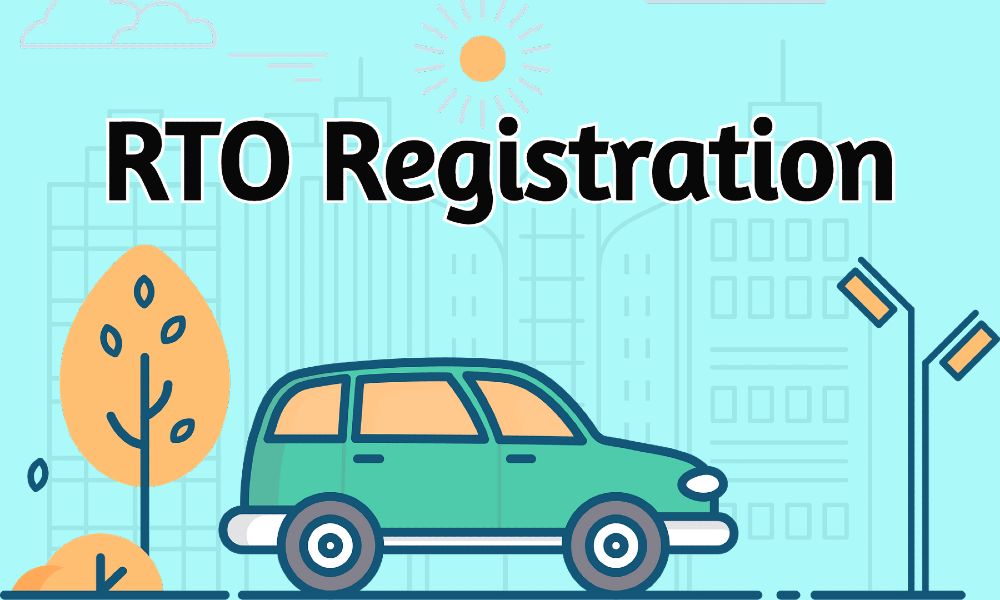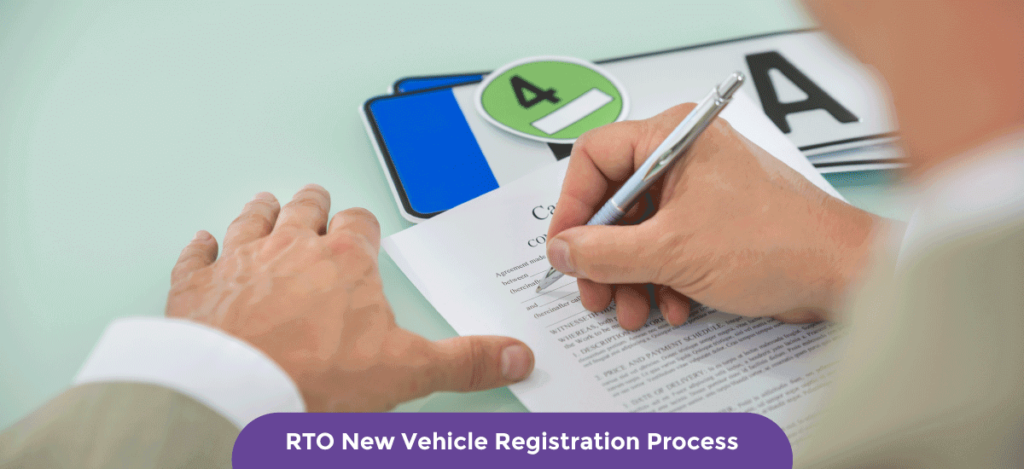Registering a new vehicle with the Regional Transport Office (RTO) is a mandatory process in India to ensure legal ownership and compliance with road regulations. Without a valid registration certificate (RC), a vehicle cannot be driven on public roads. The registration process involves submitting essential documents, paying applicable fees, and following specific steps as per RTO guidelines. Therefore, in this guide, we’ll walk you through the complete process., including required documents, fees, and step-by-step procedures to help you navigate it smoothly.
Key Points
- What is RTO Vehicle Registration?
- Why is Registration Mandatory?
- Documents Required for New Vehicle Registration
- Fees for RTO Vehicle Registration
- Step-by-Step Process for Registering a New Vehicle
- Temporary vs. Permanent Registration
- Tips to Make the Process Smooth
What is RTO Vehicle Registration?

RTO vehicle registration is like giving your new ride an official identity in India. The Regional Transport Office (RTO), which operates under the Ministry of Road Transport and Highways, assigns your vehicle a unique registration number like its own personal ID and issues a Registration Certificate (RC). Picture the RC as your vehicle’s birth certificate: it’s proof that it’s legally yours and cleared to cruise on public roads. This number (think “MH-02-AB-1234”) gets stamped on a high-security plate, and the RC ties your name to the vehicle in the government’s records. It’s not just a formality it’s essential for insurance claims, resale, and even dodging trouble with traffic cops. Without it, your vehicle’s basically a ghost on the road, and that’s a problem you don’t want.
Why is Registration Mandatory?
The Motor Vehicles Act of 1988 doesn’t mess around: every vehicle whether it’s a sleek SUV, a rugged motorcycle, or even a humble auto-rickshaw must be registered with the RTO. It’s not just bureaucracy gone wild; there’s solid logic here:
- Legal Compliance: Driving without a valid RC is a no-go. If you’re caught, expect fines starting at ₹5,000, or worse, your vehicle could be impounded.
- Ownership Proof: The RC is your golden ticket to proving the vehicle’s yours super handy if it’s stolen, sold, or caught up in a dispute.
- Road Safety: Registration involves checks to ensure your vehicle isn’t a rolling hazard and meets emission norms (hello, PUC certificate!).
- Tax Collection: That road tax you pay? It funds the highways, flyovers, and pothole repairs we all rely on. No registration, no contribution.
- Traceability: If your vehicle’s involved in an accident or crime, the registration number helps authorities track it back to you.
Skipping this step is like playing Russian roulette with the law—fines, seizures, and headaches galore. As a result, ensuring proper registration is crucial for avoiding unnecessary trouble.
Documents Required for New Vehicle Registration

Alright, let’s get organized. Here’s your checklist of must-have documents think of it as your RTO survival kit. Miss one, and you’re back to square one, so let’s nail this:
Application and Vehicle Details
- Form 20 (Application for Registration): The official registration form. You can download it from the Parivahan Sewa portal or get a hard copy at the RTO. Fill it out neatly to avoid delays.
- Sales Certificate (Form 21): Provided by the dealer, this document includes details like the make, model, sale date, and price of your vehicle.
- Roadworthiness Certificate (Form 22): Also issued by the dealer, this certificate confirms that your vehicle meets the safety and pollution standards set by the Automotive Research Association of India (ARAI).
Insurance and Financial Documents
- Insurance Certificate: A copy of your active motor insurance policy is required. Third-party insurance is mandatory, but comprehensive coverage is recommended for better protection.
- Form 34 (if applicable): If your vehicle is financed, this hypothecation form links it to the lender until the loan is fully repaid.
Proof of Ownership and Identity
- Proof of Identity: Any government-issued photo ID such as Aadhaar card, PAN card, voter ID, driving license, or passport.
- Proof of Address: Acceptable documents include Aadhaar card, a utility bill (electricity/gas), passport, or a rental agreement. Some RTOs may require two proofs—check local requirements.
- Invoice: The original purchase invoice from the dealer, which includes details like the chassis and engine numbers.
Additional Documents
- PUC Certificate: The Pollution Under Control (PUC) certificate verifies that your vehicle meets emission norms. New vehicles usually come with a six-month valid PUC certificate from the dealer.
- Passport-Size Photos: Some RTOs require two to three recent passport-size photos for records or the RC smart card.
- Temporary Registration (if issued): If the dealer provided a temporary registration number, submit the related documents. This serves as a placeholder until you receive the permanent number.
- Chassis Imprint (if required): Some RTOs may ask for a pencil rubbing of the chassis number for verification.
Pro Tip: Carry originals and two sets of photocopies. Keep everything in a folder, and call your RTO ahead random extras like a nativity certificate (in some states) might pop up!
Fees for RTO Vehicle Registration
Let’s talk money. The cost depends on your vehicle type, its price, and where you live states love tweaking their rates. Here’s a detailed rundown as of March 2025:
- Registration Fee:
- Two-wheelers: ₹300–₹600 (bikes under 150cc are cheaper).
- Cars: ₹600–₹1,500 (scales with engine size big SUVs pay more).
- Commercial vehicles: ₹1,000–₹2,000 (taxis, autos, etc.).
- Road Tax: The heavy hitter. It’s a percentage of your vehicle’s ex-showroom price:
- Delhi: 4–10% (e.g., ₹20,000–₹50,000 on a ₹5 lakh car).
- Karnataka: Up to 18% (ouch ₹90,000 on that same car).
- Maharashtra: 11–13% for cars, 7–9% for bikes.
- EVs often get a discount or full exemption check locally!
- High-Security Number Plate (HSRP): ₹230–₹400. These tamper-proof plates are mandatory nationwide now.
- Hypothecation Fee (if on loan): ₹1,500–₹2,000 to note the lender’s lien on your RC.
- Smart Card Fee: ₹200–₹300 for the fancy RC smart card with a chip.
- FasTag: ₹500–₹600. It’s compulsory for tolls your dealer might bundle it with the sale.
- Late Penalty (if delayed): ₹300–₹500/month for bikes, ₹1,000+/month for cars if you miss the 30-day temporary registration window.
- Miscellaneous: Some RTOs sneak in extras like a ₹50 postal fee or ₹100 for fancy number auctions.
Example: A ₹5 lakh car in Tamil Nadu might total ₹60,000–₹80,000 (mostly road tax), while a ₹1.5 lakh bike in UP could be ₹10,000–₹15,000. Hit up your state’s RTO site or the VAHAN portal for precise slabs rates shift, and EVs might save you a chunk!
Step-by-Step Process for Registering a New Vehicle

Here’s the playbook whether you’re DIY-ing it or leaning on your dealer:
- Gather Documents: Round up everything from the checklist. Triple-check names, numbers, and dates typos can stall you.
- Visit the RTO or Dealer: If you’re self-registering, head to your local RTO (find it on parivahan.gov.in). Most dealers handle this for free confirm with yours to save the trip.
- Submit Application: Fill out Form 20 (pen or online), attach your docs, and submit. RTO staff will eyeball everything for completeness.
- Pay Fees: Hit the fee counter with cash, card, or demand draft (call ahead some spots are cash-only). You’ll cover registration, road tax, HSRP, etc. Keep that receipt safe!
- Vehicle Inspection: An Inspector of Motor Vehicles (IMV) checks your ride matches chassis/engine numbers, tests lights, brakes, and horns, and ensures it’s not a lemon.
- Data Entry: Your vehicle’s deets (make, model, fuel type, color) get logged into the VAHAN database India’s central vehicle registry.
- Approval: The Assistant Regional Transport Officer (ARTO) gives the final nod. If anything’s off (say, a missing PUC), they’ll flag it.
- Get Your RC: Once cleared, your RC smart card and registration number arrive by post in 1–3 weeks. Some RTOs let you pick it up sooner ask!
Online Option: Start on the Parivahan portal upload docs, pay fees, and book an inspection slot. You’ll still need to wheel your vehicle to the RTO for the physical once-over.
Temporary vs. Permanent Registration
- Temporary Registration: Issued by the dealer when you buy. It’s a 30-day pass your vehicle gets a yellow plate with red lettering (e.g., “TEMP MH-01-123”). It’s valid nationwide but expires fast, so don’t dawdle. Cost? Usually ₹1,500–₹2,000, baked into the dealer’s fee.
- Permanent Registration: The RTO’s big leagues. After the process above, you get a unique number (e.g., “KA-05-XX-5678”) on a high-security plate and an RC smart card. It’s good for 15 years for private vehicles (5 years for commercial ones), renewable later. Conversion from temp to permanent is mandatory driving with an expired temp risks a ₹5,000 fine or impounding.
Heads-Up: Some dealers drag their feet nag them to file for permanent registration ASAP, or you’re stuck with the clock ticking!
Tips to Make the Process Smooth
- Call Your RTO: Every state’s a little different. Phone them or scope their website (e.g., transport.tn.gov.in) for local quirks.
- Dealer Shortcut: If they offer registration, say yes! It’s often free and skips the RTO runaround just verify they’ve filed on time.
- Go Early: RTOs are zoos by noon. Aim for 9 AM to beat the crowd and grumpy staff.
- Track Online: Plug your temp number or application ID into the VAHAN portal (vahan.parivahan.gov.in) to see where things stand.
- Insurance First: No policy, no dice RTOs won’t touch your file without it. Get it day one.
- Cash is King: Some counters still shun cards bring ₹5,000–₹10,000 in cash or a demand draft to be safe.
- Agent Option: If it’s too much hassle, local RTO agents (₹1,000–₹2,000) can grease the wheels just pick a legit one.
Bonus: Double-check your HSRP it’s a must, and fake plates can land you in hot water with cops.
Conclusion
Completing the RTO new vehicle registration process is essential for legally driving on Indian roads. By submitting the necessary documents, paying the required fees, and following the prescribed steps, you can ensure a hassle-free registration. Staying informed about the process helps avoid delays, fines, or legal issues. Once registered, your vehicle receives a unique registration number, making it road-legal and officially recognized by the authorities. Follow the correct procedures, and you’ll be ready to hit the road with confidence.
FAQs
Q1: How long does the RTO registration process take?
Ans. If you have all the required documents, the RTO typically processes the application within 1–2 days. After that, it takes an additional 7–15 days for the RC to be delivered by mail. However, using online application methods can reduce this waiting period—check your state’s portal for faster processing.
Q2: Can I drive my vehicle without permanent registration?
Ans. Yep, but only with a temporary number (30 days max). Post that, it’s illegal ₹5,000 fine or worse.
Q3: What happens if I miss the temporary registration deadline?
Ans. Late fees kick in ₹300–₹500/month for bikes, ₹1,000+ for cars. Plus, you’re a target for traffic cops.
Q4: Can I choose my registration number?
A: Some RTOs auction VIP numbers (like 0001 or 9999) for ₹5,000–₹1 lakh, depending on demand.
Q5: Is the process different for electric vehicles?
A: Same steps, but road tax is often lower (e.g., 0% in Telangana) or waived. Confirm with your RTO EVs are the darlings of 2025!
Q6: Do I need to register in the state I bought the vehicle?
A: Nope register where you live. If it’s from another state, grab a No Objection Certificate (NOC) from that RTO first.








